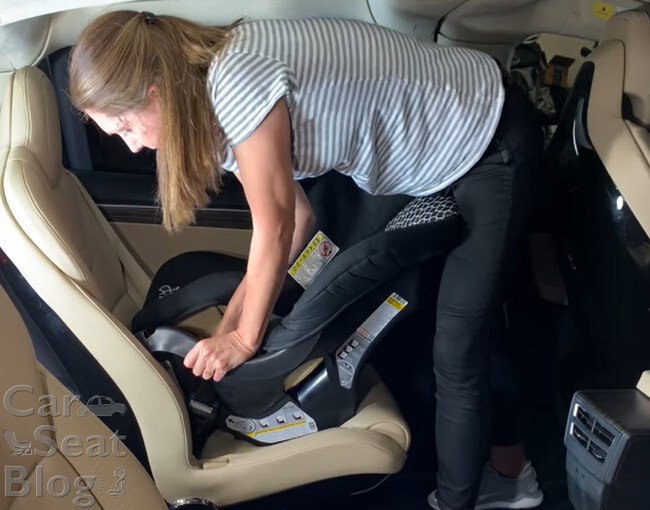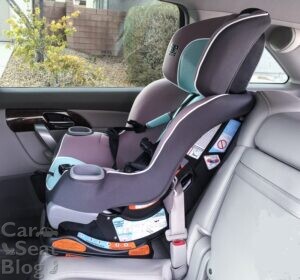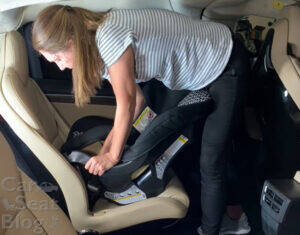Mythbusting: You Can Damage Your Car Seat by Installing it Too Tightly

![]()
![]()
![]()
![]()
![]()
Myth: A rock-solid, shake-the-car installation is not ideal and you could break your carseat or damage the seatbelt
 Is it bad or wrong to install your car seat so tightly that you shake the whole car when you’re testing to make sure it’s tight? That question comes up frequently so we wanted to explore the issue – look at the facts, talk to carseat engineers, and set the record straight once and for all.
Is it bad or wrong to install your car seat so tightly that you shake the whole car when you’re testing to make sure it’s tight? That question comes up frequently so we wanted to explore the issue – look at the facts, talk to carseat engineers, and set the record straight once and for all.
First, a little background info – when carseats are crash tested in a lab, the tension on the belt webbing has to measure between 53.5 N (newtons) and 67 N. That tension is measured by a load cell device placed on the webbing. This is done to maintain repeatability between tests. The tension range was chosen because it represents the average tightness achieved by parents in the field.
In the real world, no one expects parents and caregivers to measure the tension on the seatbelt or LATCH strap that is securing their carseat. CPS Technicians are taught that a carseat is properly installed if it moves less than 1” from side-to-side and front-to-back when you check for tightness at the beltpath.
But is it possible to install your carseat too tightly? To the point of it being a detriment instead of a benefit?
In most cases, there is no such thing as too tight – only too loose. If you’re just using typical human strength and maybe a few installation tricks like getting behind a rear-facing carseat or using the reclining seatback trick, you do not have to worry about getting the seatbelt or LATCH strap too tight. Carseats and seatbelts are not delicate objects that are going to be compromised by a really tight installation.

Remember the [simple but not technically accurate] weight x speed equation that we use to teach parents and caregivers how much restraining force is needed to keep their child restrained in a crash? Guess what? Your carseat is designed to withstand 1,200 lbs. of force or more in a crash! And the seatbelts and retractors in your vehicle are designed to restrain a 200 lb. adult in a 35 mph crash. That’s 7,000 lbs. of restraining force! Even an Olympic weightlifter cannot install a carseat with 1200 lbs. of force so don’t worry that your tight installation is somehow going to hurt your carseat or your vehicle.

FACT: The tighter you can couple the carseat to the vehicle, the better. This is why rigid LATCH/ISOFIX attachments are so beneficial!
In reality, during a crash the difference between a carseat installed rock-solid and a carseat installed acceptably with just a little bit of movement at the beltpath, is negligible. Don’t convince yourself that a rock-solid install is going to keep that seat from moving during a moderate to severe crash – but it’s certainly better than starting out in a crash with a loose installation.
However, there could be cases where too tight is possible. If you’re installing a carseat that has an integrated mechanical advantage feature – like a Britax with ClickTight, Graco with SnugLock, or Chicco with SuperCinch, you need to follow the manufacturer’s directions and guidance for proper installation.
For carseats that don’t have a built-in mechanical advantage, if you can use a few tricks or installation techniques and achieve a really solid installation, that’s great. But if you’re fighting with the install and the best you can achieve is just a little bit of side-to-side or front-to-back movement and it’s not more than 1″ of movement, that’s perfectly okay too. It’s not always possible to get a rock-solid install but if you can – there is certainly nothing bad or wrong with that.
In my vehicle with stiff leather seats, I almost always need to put a knee in a forward-facing carseat to get an acceptable install. Occasionally I need to put a knee in the seat AND use the reclining seatback trick. These are easy things for me to do quickly and it sure beats wrestling with an install for 20 minutes.
Ultimately, you always want to read and follow the carseat manufacturer’s recommendations. There are situations where getting the seatbelt too tight will prevent you from closing a lockoff (or a Britax ClickTight compartment) because there is too much tension on the belt. There are also situations where a LATCH belt with hook connectors is so tight that you can’t get enough slack in the belt to loosen it when you have to take it out. (Tip: if this happens on a vehicle seat that reclines – recline the vehicle seat back then apply downward pressure to the carseat or base and that should introduce enough slack to allow you to loosen the LATCH belt).
Obviously, in these cases, you have a compelling circumstance and you may need to lighten up a little on your regular installation technique.
Bottom line: Unless there is some compelling reason not to, install the carseat as tight as you can with reasonable effort (key words) but don’t feel guilty if you cannot get it rock-solid. On the flip side, it’s not bad or wrong if you can get that sucker installed like it’s part of the car with a reasonable amount of effort. 🙂
We’re going to say that this Myth is PLAUSIBLE simply because there are many seats on the market that have some sort of integrated mechanical advantage and if you go overboard that could potentially create issues. However, for seats that lack a mechanical advantage feature, this myth is definitely BUSTED.
![]()
![]()
![]()
![]()
![]()
![]()






